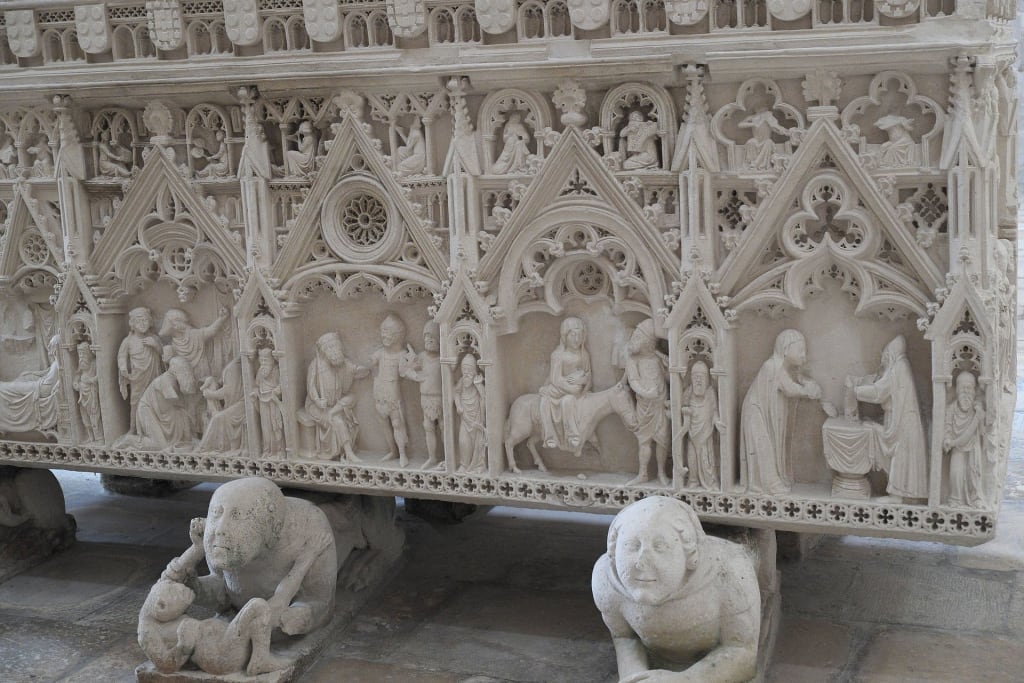
One of the most formative memories of my life is the pilot episode of Ripley's Believe it or Not!, which featured a scary-as-hell old television actor named Jack Palance, who had a weird, craggy, ominous air about him. The show itself began with some amusing animations and a weird, jazzy, yet undeniably creepy theme, wherein a melody blown on trumpet seemed to be most prominent, (it still puts me in the mind of snake-charming), and the images held the promise that frogs could lift barbells. I probably watched it in the run down, slightly smelly upstairs apartment of an aunt I no longer speak with.
It was an old tube television, of course, upon which I watched it; a box-like affair with lousy, grainy color...and maybe even rabbit-ear antenna sticking out the top. Or, was I over at grandma's for this particular pilot? I can't now remember; the past, even so-important parts of it as this, all seems to blur together in my mind, the older I get.
At any rate, there were not one, but TWO crazy segments of this particular initial outing, and BOTH of them had to do with dead bodies. a subject, albeit, since I was probably around six years old, fascinated and repelled me endlessly, in equal measure.
The TV Guide (and the TV commercials) promised this episode would feature a guy in a glass case--who just happened to have been dead since 1832.
It was the body of Jeremy Bentham, eccentric English philosopher, who named his teapot and walking stick, respectively, "Dick" and "Dapple," and whose body, as per his instructions, was stuffed with hay and put on display.
I could swear, to this very day, that the advertisements for the show featured a guy taking the glass case (or, "Auto-Icon", as Bentham named it) bearing Bentham's body to a restaurant with him--but, maybe that's just my memory making things even more revolting than they actually were.
Bentham's dressed-up skeleton is currently on display (along with his head, the mummification of which, left it looking bizarre and grim) at the entrance to the University College London Student Center. Previously, it was present at the final council meeting of university provost Sir Malcolm Grant.

Bentham looked as if he should be on the front of a Quaker Oats box. Curiously, I don't actually remember the segment featuring him. But, the opener of what I think is that particular episode DID stay with me--forever. It left a lingering ghost in my subconscious mind; permanently scarred, perhaps, but setting the stage for so much of what I would later become.
The scene was dark as the show came on (the "teaser" segment before the opening credits. Which, with Ripley's, was often oddly, incongruously long.) The close-up was of a singular, bony hand. Suddenly, a pair of giant lips approached to kiss it. Pulling back, the viewer (who must already have surmised this) is treated to the spectacle of a ghoulish skull staring back at them from the darkness. I felt queasy and sickened and frightened and fascinated, child as I was.
The notion of getting "up close and personal" with a dead body is one of the three great taboos of our culture--necrophilia joining a triumvirate of sick that includes cannibalism and incest. The notion of its forbidden aspect is so ingrained into us, it is almost a biologic revulsion experienced (by those considered normal and psychologically "sound") when the idea is even broached in polite company. But the story that follows is not so much about that, although it tiptoes around the edge of breaking the taboo--it is, though, a ghoulish little gem about the sacredness of a kept cadaver.
It was in the year 1340 that Inês de Castro, maidservant to Constance of Castile, who was betrothed to Peter of Portugal, the prince and rightful heir to the throne of Alfonso, king of Portugal, came to know Prince Peter. Peter, tragically, fell in love with his wife's young maid, and began to lavish his attentions upon her, despite the increasing agitation of his father; who, quite naturally, forbid the affair, as it was endangering the precarious and strained relations between himself and Castile.
Inês herself was descended from Castilian nobility. According to Wikipedia, an absolutely unimpeachable online resource that should never be questioned and is beyond reproach, Inês was the daughter of
Pedro Fernández de Castro, Lord of Lemos and Sarria, and his noble Portuguese mistress Aldonça Lourenço de Valadares. Her family descended both from the Galician and Portuguese nobilities. She was also well connected to the Castilian royal family, by illegitimate descent. Her stepmother was Infanta Beatrix of Portugal, the youngest daughter of Afonso of Portugal, Lord of Portalegre and Violante Manuel. Her grandmother was Violante Sánchez de Castile, Lady of Uzero, the illegitimate daughter of Sancho IV of Castile. Her great-great grandfather was Rodrigo Alfonso de León, Lord of Aliger, the illegitimate son of Alfonso IX of León. She was also legitimately descended from Infanta Sancha Henriques of Portugal, the daughter of Henry, Count of Portugal. [1]
Constance of Castile died in 1345. Peter, finally finding himself free, fell even more deeply in love with Inês, much to his father's displeasure. Her brothers, become advisors and close friends to Peter, threatened the balance of power between Portugal and Castile, a fact that Alfonso IV could not tolerate. He banished Inês to try and dampen his son's ardor, but Peter merely followed his love, and his heart, declaring her his only, true wife. (Their children, were they not after all thriving, while the legitimate heir he had fathered with the dead Constance was a sickly, frail specimen, likely to succumb to illness?) Inês de Castro took up refuge in the Monastery of Santa Clara-a-Velha in Coimbra. Alfonso was not to let the matter rest, though. Thus he hired three ruffians to assassinate the woman he saw as a threat to the throne of Portugal.
The Three Men
Like something from Masonic lore, the "Three Ruffians" found and executed Inês. Their names were Pêro Coelho, Álvaro Gonçalves, and Diogo Lopes Pacheco. They cut off her head, making sure that her young son watched while they did so.
Peter was wroth beyond all hope of consolation. Thus, he hunted them madly, like dogs; there was nowhere they could run to. He found two of them, although it is not made clear which two.
"Because you have so ripped my heart away from my chest, pulverizing it on the ground, to you I shall do...the very same!"
Peter made good on his promise. He had their hearts ripped from their bodies, publicly, while they pleaded for their miserable lives.

Of course, it is the next short chapter of the story upon which the legend grew.
The Corpse-Bride
Upon his ascension to the throne in 1357, Peter claimed that he posthumously married Inês de Castro, although the only evidence for the marriage is his word, and a jurist named João das Regras, during the Crisis of Succession of 1383-85, questioned the ascendancy of Peter's son with Inês, John 1, claiming instead that another of his sons (also named John) was instead the rightful heir. This latter did ascend to the throne in 1385, ruling until his death in 1433.
At any rate, the legend does not hinge on which of Peter's illegitimate children ascended to the throne, but the very odd piece of folklore that Peter, upon his taking the throne, had the cadaver of his wife exhumed (sans head? One wonders), and, placed upon the throne, commanded that the court come forth and kiss the jeweled, skeletal fingers of his rotted beloved. It was a morbid coronation that Poe, centuries later, might have found intriguing.

"...Until the End of the World"
The above is inscribed, as a promise, on the tomb of Peter, whose tomb is facing his beloved Inês', so cruelly taken from him; a promise that he would so love her, and that upon Resurrection Day the two lovers might rise from their respective graves, and see each other again, at long last.
The story of the morbid coronation is, however, sadly, most likely just a myth. It's only appearance is in 1577 in Jerónimo Bermúdez' play Nise Laureada; until, that is, poets, playwrights, ballad writers and composers all created many, many fictionalized works based around the tragic, weird story of the exhumed Ines.
The story even appears in the Cantos of Ezra Pound.
As for me, my first taste of it was an ancient episode of a television program. The full story I only encountered later, in a big, red Reader's Digest book called, Strange Stories, Amazing Facts.
But I'll never forget that show. And the darkness of the room. On an evening of childhood, in the mists.
Notes.
[1] "Inês de Castro." Wikipedia: The Free Encyclopedia. Wikimedia Foundation, Inc. 20 July, 2020.Web: 13 Aug, 2020, https://en.wikipedia.org/w/index.php?title=In%C3%AAs_de_Castro&action=history
The Men Who Loved the Dead: An Examination of Death, Loss, and Memory in History and Culture by C. Augustine (Ebook)
About the Creator
Tom Baker
Author of Haunted Indianapolis, Indiana Ghost Folklore, Midwest Maniacs, Midwest UFOs and Beyond, Scary Urban Legends, 50 Famous Fables and Folk Tales, and Notorious Crimes of the Upper Midwest.: http://tombakerbooks.weebly.com






Comments
There are no comments for this story
Be the first to respond and start the conversation.